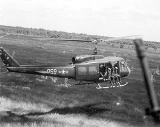
-era military conflict
that occurred in Vietnam
, Laos
, and Cambodia
from 1 November 1955 to the fall of Saigon
on 30 April 1975. This war followed the First Indochina War
and was fought between North Vietnam
, supported by its communist
allies, and the government of South Vietnam
, supported by the United States
and other anti-communist
nations. The Viet Cong (also known as the National Liberation Front, or NLF), a lightly armed South Vietnamese communist-controlled common front
, largely fought a guerrilla war
against anti-communist forces in the region.
1945 Vietnam War: Viet Minh led by Ho Chi Minh take power in Hanoi, Vietnam.
1957 Vietnam War: First United States casualties in Vietnam.
1962 Vietnam War: After a trip to Vietnam at the request of US President John F. Kennedy, US Senate Majority Leader Mike Mansfield becomes the first American official not to make an optimistic public comment on the war's progress.
1963 Vietnam War: Following the November 1 coup and execution of President Ngo Dinh Diem, coup leader General Duong Van Minh takes over leadership of South Vietnam.
1963 Vietnam War: Newly sworn-in US President Lyndon B. Johnson confirms that the United States intends to continue supporting South Vietnam both militarily and economically.
1964 Vietnam War: An explosion sinks the USS ''Card'' while docked at Saigon. Viet Cong forces are suspected of placing a bomb on the ship.
1964 Vietnam War: at a rally in Saigon, South Vietnamese Prime Minister Nguyen Khanh calls for expanding the war into North Vietnam.
1964 Vietnam War: Viet Cong forces attack the capital of Dinh Tuong Province, Cai Be, killing 11 South Vietnamese military personnel and 40 civilians (30 of which are children).
1964 Vietnam War: 5,000 more American military advisers are sent to South Vietnam bringing the total number of United States forces in Vietnam to 21,000.
1964 Vietnam War: Vietnam War: Vietnam War: [[Gulf of Tonkin Incident

